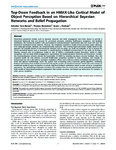Top-Down Feedback in an HMAX-Like Cortical Model of Object Perception Based on Hierarchical Bayesian Networks and Belief Propagation
| dc.contributor.author | Dura-Bernal, S | |
| dc.contributor.author | Wennekers, Thomas | |
| dc.contributor.author | denham, susan | |
| dc.date.accessioned | 2017-02-13T13:57:33Z | |
| dc.date.available | 2017-02-13T13:57:33Z | |
| dc.date.issued | 2012-11-05 | |
| dc.identifier.issn | 1932-6203 | |
| dc.identifier.issn | 1932-6203 | |
| dc.identifier.other | e48216 | |
| dc.identifier.uri | http://hdl.handle.net/10026.1/8455 | |
| dc.description | PubMed ID: 23139765 | |
| dc.description.abstract |
Hierarchical generative models, such as Bayesian networks, and belief propagation have been shown to provide a theoretical framework that can account for perceptual processes, including feedforward recognition and feedback modulation. The framework explains both psychophysical and physiological experimental data and maps well onto the hierarchical distributed cortical anatomy. However, the complexity required to model cortical processes makes inference, even using approximate methods, very computationally expensive. Thus, existing object perception models based on this approach are typically limited to tree-structured networks with no loops, use small toy examples or fail to account for certain perceptual aspects such as invariance to transformations or feedback reconstruction. In this study we develop a Bayesian network with an architecture similar to that of HMAX, a biologically-inspired hierarchical model of object recognition, and use loopy belief propagation to approximate the model operations (selectivity and invariance). Crucially, the resulting Bayesian network extends the functionality of HMAX by including top-down recursive feedback. Thus, the proposed model not only achieves successful feedforward recognition invariant to noise, occlusions, and changes in position and size, but is also able to reproduce modulatory effects such as illusory contour completion and attention. Our novel and rigorous methodology covers key aspects such as learning using a layerwise greedy algorithm, combining feedback information from multiple parents and reducing the number of operations required. Overall, this work extends an established model of object recognition to include high-level feedback modulation, based on state-of-the-art probabilistic approaches. The methodology employed, consistent with evidence from the visual cortex, can be potentially generalized to build models of hierarchical perceptual organization that include top-down and bottom-up interactions, for example, in other sensory modalities. | |
| dc.format.extent | n/a- | |
| dc.format.medium | Print-Electronic | |
| dc.language | en | |
| dc.language.iso | en | |
| dc.publisher | Public Library of Science (PLoS) | |
| dc.subject | Algorithms | |
| dc.subject | Bayes Theorem | |
| dc.subject | Cerebral Cortex | |
| dc.subject | Culture | |
| dc.subject | Feedback, Physiological | |
| dc.subject | Humans | |
| dc.subject | Imagery, Psychotherapy | |
| dc.subject | Models, Neurological | |
| dc.subject | Perception | |
| dc.title | Top-Down Feedback in an HMAX-Like Cortical Model of Object Perception Based on Hierarchical Bayesian Networks and Belief Propagation | |
| dc.type | journal-article | |
| dc.type | Article | |
| plymouth.author-url | http://gateway.webofknowledge.com/gateway/Gateway.cgi?GWVersion=2&SrcApp=PARTNER_APP&SrcAuth=LinksAMR&KeyUT=000310741400042&DestLinkType=FullRecord&DestApp=ALL_WOS&UsrCustomerID=11bb513d99f797142bcfeffcc58ea008 | |
| plymouth.issue | 11 | |
| plymouth.volume | 7 | |
| plymouth.publication-status | Published online | |
| plymouth.journal | PLOS ONE | |
| dc.identifier.doi | 10.1371/journal.pone.0048216 | |
| plymouth.organisational-group | /Plymouth | |
| plymouth.organisational-group | /Plymouth/Admin Group - REF | |
| plymouth.organisational-group | /Plymouth/Admin Group - REF/REF Admin Group - FoSE | |
| plymouth.organisational-group | /Plymouth/Faculty of Science and Engineering | |
| plymouth.organisational-group | /Plymouth/Faculty of Science and Engineering/School of Engineering, Computing and Mathematics | |
| plymouth.organisational-group | /Plymouth/REF 2021 Researchers by UoA | |
| plymouth.organisational-group | /Plymouth/REF 2021 Researchers by UoA/UoA04 Psychology, Psychiatry and Neuroscience | |
| plymouth.organisational-group | /Plymouth/REF 2021 Researchers by UoA/UoA11 Computer Science and Informatics | |
| plymouth.organisational-group | /Plymouth/Research Groups | |
| plymouth.organisational-group | /Plymouth/Research Groups/Centre for Brain, Cognition and Behaviour (CBCB) | |
| plymouth.organisational-group | /Plymouth/Research Groups/Centre for Brain, Cognition and Behaviour (CBCB)/Brain | |
| plymouth.organisational-group | /Plymouth/Users by role | |
| plymouth.organisational-group | /Plymouth/Users by role/Academics | |
| dc.publisher.place | United States | |
| dcterms.dateAccepted | 2012-09-25 | |
| dc.identifier.eissn | 1932-6203 | |
| dc.rights.embargoperiod | Not known | |
| rioxxterms.versionofrecord | 10.1371/journal.pone.0048216 | |
| rioxxterms.licenseref.uri | http://www.rioxx.net/licenses/all-rights-reserved | |
| rioxxterms.type | Journal Article/Review |


